Diet composition of Indian flying fox (Pteropus giganteus) in Kathmandu Valley
DOI:
https://doi.org/10.3126/njes.v7i0.34412Keywords:
Diet composition, Fecal analysis, Pollination, Seed dispersalAbstract
The composition of diet reflects the food availability and food preference by wildlife in their respective habitat. Flying fox (Pteropus giganteus) is the largest bat species that inhabit the urban area of Kathmandu Valley. The diet composition of Flying fox and their conservation threat was studied from January to April 2018. Bats roosting at Kesharmahal, Kathmandu and Sallaghari, Bhaktapur were selected for the study. The diet consumed was explored by micro-histological analysis from fresh fecal samples (guano) and bolus collected from the roost site. The samples were collected by spreading plastic sheets of 2m × 2m for a whole day. The droppings from bats were collected on 50 mL vials with 70% alcohol. Altogether 140 samples were collected. The collected droppings were used to micro histological slides where the seeds were isolated and identified using a hand lens. The pollens presence in slides were observed under the compound microscope and tallied with the reference slides for identification. Altogether 17 and 10 different plant families were identified from dropping of bats from Kesharmahal and Sallaghari, respectively. Among them, Moraceae and Myrtaceae were common diets in bats of both locations. Our result shows P. giganteus consumes food from the Myrtaceae, Brassicaceae, Malvaceae, Apiaceae, Pinaceae, Fagaceae, Proteaceae and Anacardiaceae families in Kathmandu Valley. P. giganteus mostly depend on foods present nearby the roost and also flies far away in search of food, which is comparatively minimal.
Downloads
Downloads
Published
How to Cite
Issue
Section
License
This license enables reusers to distribute, remix, adapt, and build upon the material in any medium or format for noncommercial purposes only, and only so long as attribution is given to the creator.




